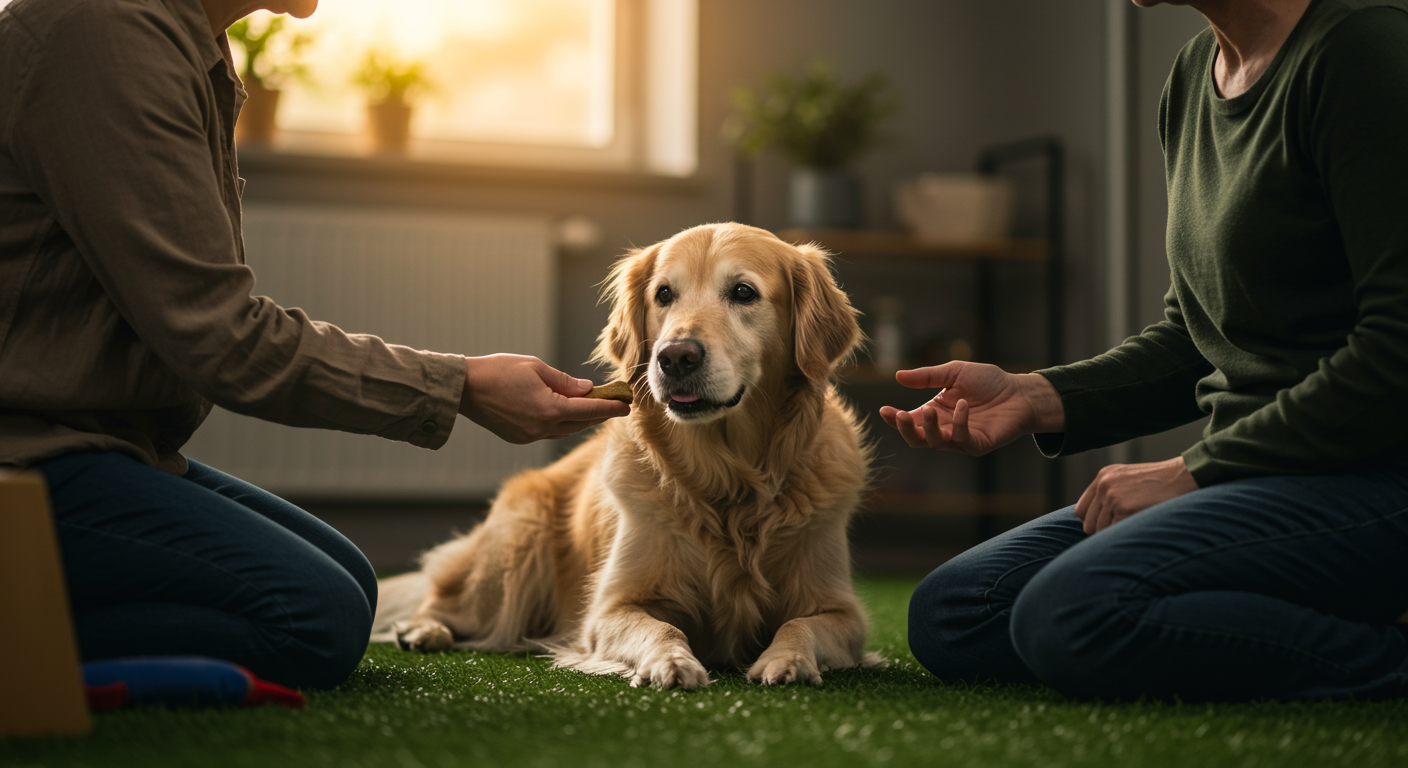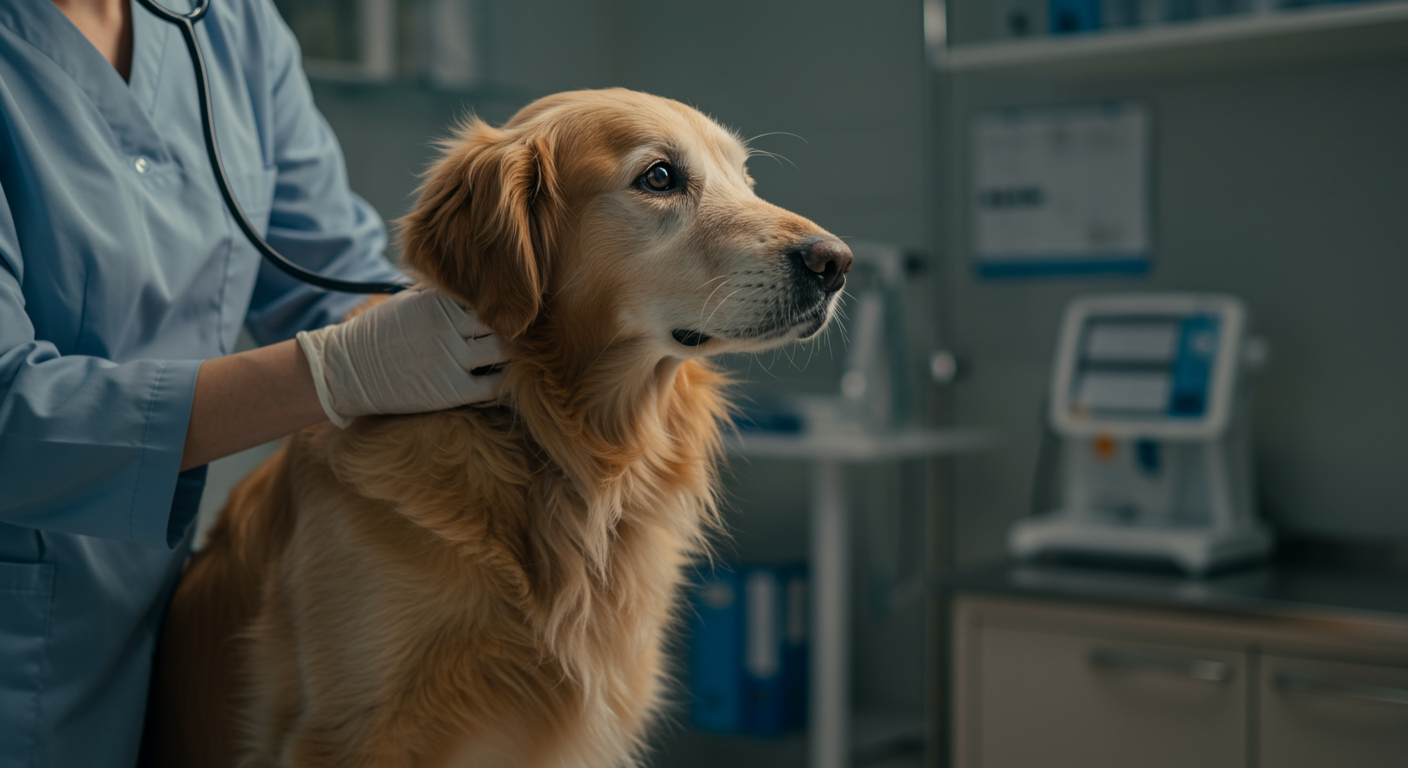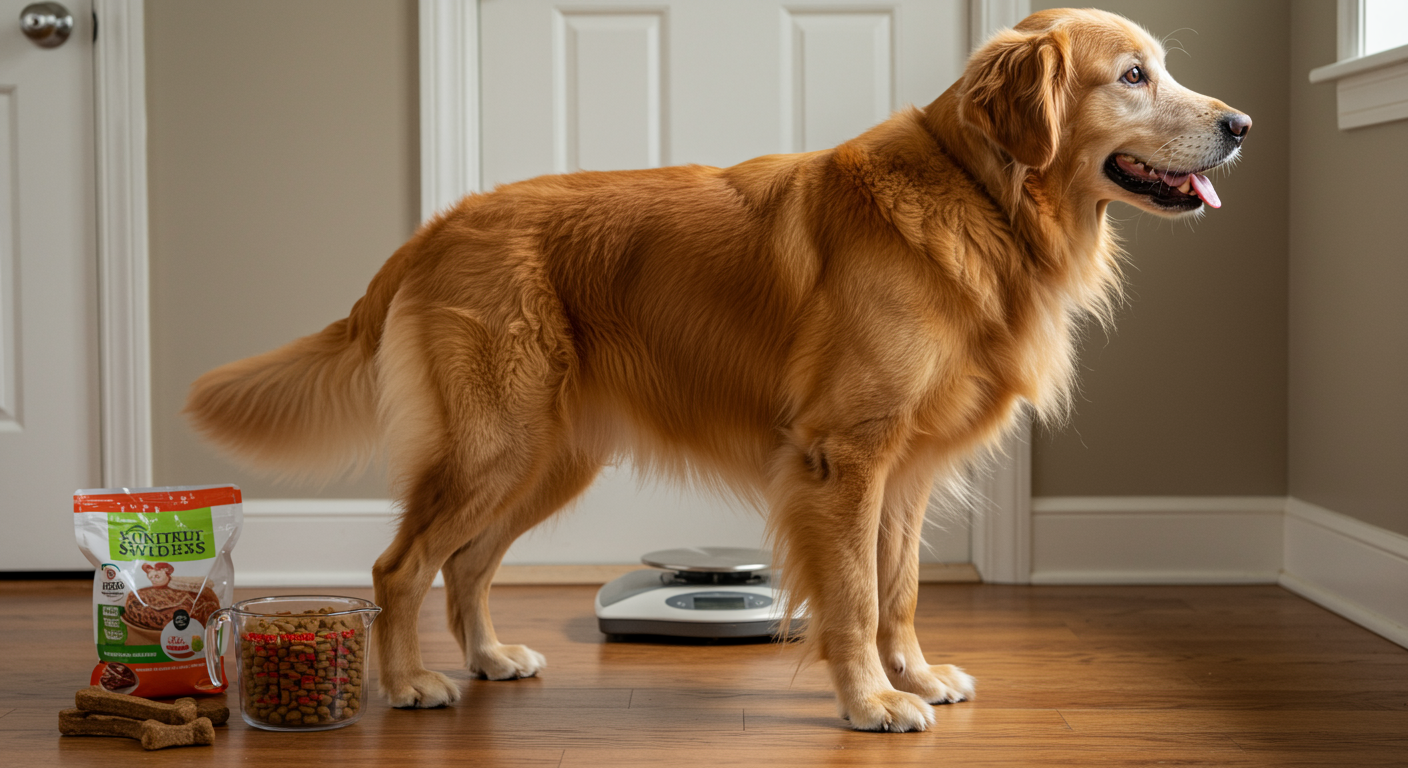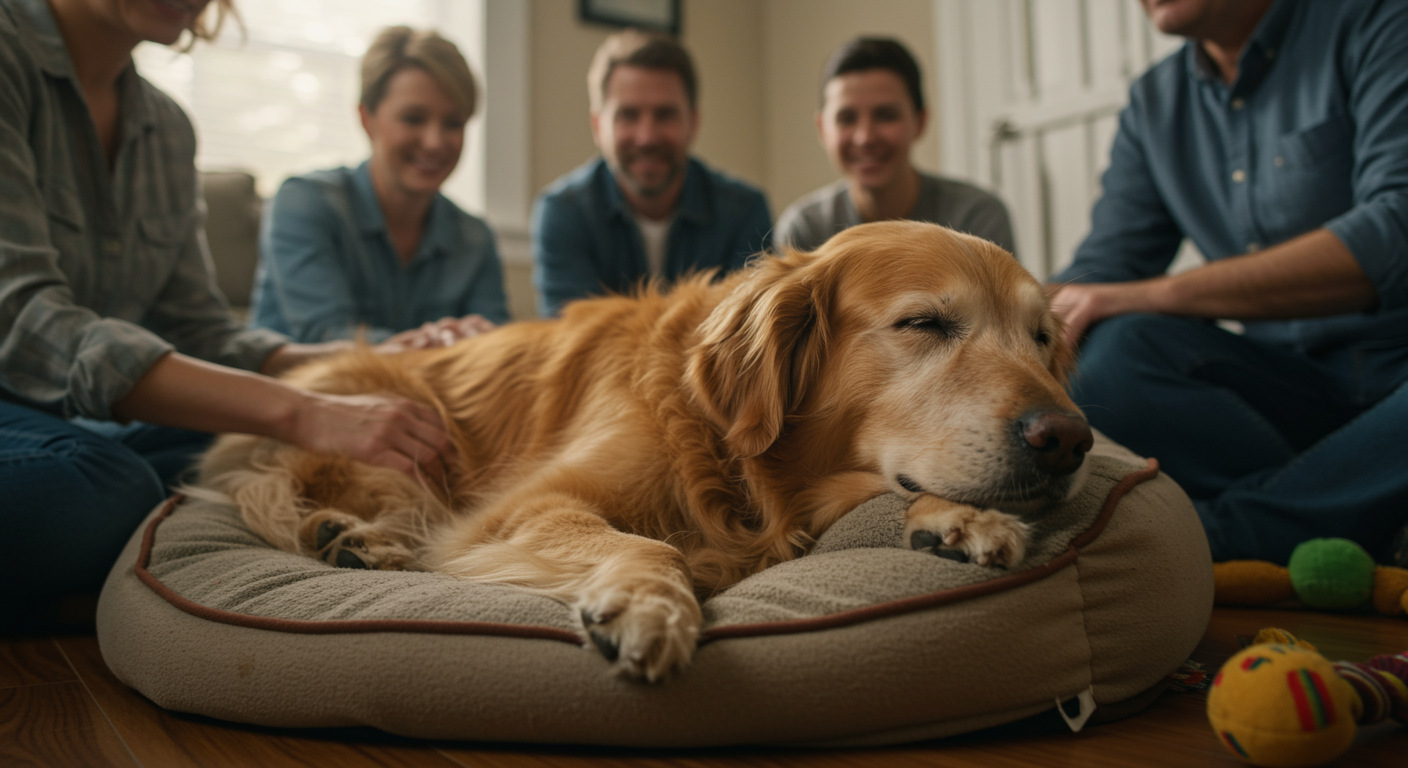Training senior Golden Retrievers requires a fundamentally different approach than training younger dogs, emphasizing gentle methods, patient progression, and respect for the physical and cognitive changes that come with aging. Understanding how to adapt training techniques helps maintain mental stimulation and behavioral management while accommodating the unique needs and capabilities of senior companions.
Senior Golden Retrievers can continue learning throughout their lives, but they may require modified approaches that account for potential hearing changes, vision limitations, arthritis affecting movement, or cognitive shifts that influence learning speed and retention. Successful training focuses on positive reinforcement, shorter sessions, and realistic expectations.
Effective senior dog training prioritizes comfort, builds on existing knowledge, and creates positive experiences that strengthen the human-dog bond while addressing behavioral needs or teaching new skills that support quality of life during the golden years.
Understanding Senior Learning Capabilities
Cognitive Changes and Learning Adaptation
Memory and Processing Considerations
Senior Golden Retrievers may experience slower information processing and occasional memory challenges that require training approaches with more repetition, patience, and consistent reinforcement to achieve successful learning outcomes.
Understanding that learning may take longer helps families maintain realistic expectations while celebrating small improvements and maintaining motivation for continued training efforts that benefit both mental stimulation and behavioral management.
Cognitive flexibility may be reduced in senior dogs, making it more challenging to modify established behaviors or learn completely new concepts, requiring training approaches that build on familiar foundations.
Attention Span Modifications
Senior dogs often have shorter attention spans due to physical discomfort, fatigue, or cognitive changes, making brief, frequent training sessions more effective than longer, intensive training periods.
Understanding attention limitations helps trainers structure sessions that maximize learning while preventing frustration or exhaustion that could create negative associations with training activities.
Monitoring for signs of fatigue or decreased engagement helps ensure that training sessions remain positive and productive rather than overwhelming or stressful for senior learners.
Physical Limitations Affecting Training
Mobility and Movement Considerations
Arthritis, joint stiffness, or other mobility issues may limit the types of physical behaviors that senior Golden Retrievers can perform comfortably, requiring adaptations in training expectations and methods.
Understanding physical limitations helps trainers modify exercises and commands to accommodate comfort levels while still providing meaningful mental stimulation and behavioral management opportunities.
Alternative behaviors that achieve similar training goals can be substituted when traditional responses are physically challenging, ensuring that training remains accessible and comfortable.
Sensory Changes Impact
Hearing or vision changes common in senior dogs may require modifications in training cues, communication methods, and environmental setup to ensure that training remains effective and accessible.
Understanding sensory limitations helps trainers adapt visual or auditory cues while potentially incorporating tactile signals that remain accessible regardless of sensory changes.
Training environments may need modification to accommodate sensory changes, such as improved lighting for dogs with vision issues or closer proximity for dogs with hearing challenges.
Gentle Training Methods and Techniques
Positive Reinforcement Emphasis
Reward-Based Learning Strategies
Senior Golden Retrievers respond particularly well to positive reinforcement approaches that create pleasant associations with training while avoiding stress or anxiety that could negatively impact their comfort and well-being.
Understanding the importance of positive experiences helps trainers select rewards that are meaningful and motivating for individual senior dogs, whether food, praise, toys, or other preferred reinforcers.
Immediate reward delivery becomes particularly important for senior dogs who may have shorter attention spans or memory challenges that require clear connections between behavior and positive outcomes.
Stress Reduction Techniques
Training approaches that minimize stress help ensure that senior dogs remain comfortable and engaged while preventing anxiety that could interfere with learning or create negative associations with training activities.
Understanding stress signals in senior dogs helps trainers recognize when sessions should be shortened or modified to maintain positive experiences that support continued learning motivation.
Creating calm, predictable training environments helps senior dogs feel secure while focusing on learning rather than managing environmental stressors that could interfere with concentration.
Adapted Training Protocols
Modified Session Structure
Shorter training sessions lasting 5-10 minutes help accommodate senior attention spans while preventing fatigue that could interfere with learning or create negative associations with training activities.
Understanding optimal session length helps trainers maximize learning opportunities while respecting energy limitations and comfort needs that may vary from day to day.
Multiple brief sessions throughout the day can be more effective than single longer sessions, providing repeated learning opportunities while maintaining engagement and preventing overwhelm.
Senior Dog Training Methodology Guide
| Training Aspect | Traditional Approach | Senior-Adapted Method | Key Modifications | Success Indicators |
|---|---|---|---|---|
| Session Duration | 15-30 minutes | 5-10 minutes | Shorter, more frequent | Maintained attention, enthusiasm |
| Physical Demands | Full range of motion | Modified for comfort | Accommodate limitations | Willing participation, no discomfort |
| Repetition Rate | Standard progression | Increased repetition | More practice opportunities | Gradual improvement, retention |
| Reward Timing | Standard intervals | Immediate delivery | Faster reinforcement | Clear understanding, motivation |
| Environmental Setup | Standard conditions | Optimized for senses | Better lighting, closer proximity | Confident response, engagement |
| Progression Speed | Normal advancement | Slower, patient progression | Respect individual pace | Steady progress, reduced stress |
Specific Training Applications
Basic Command Refresher
Reinforcing Established Behaviors
Review and reinforcement of previously learned commands helps maintain behavioral responsiveness while providing mental stimulation that supports cognitive health in senior dogs.
Understanding the value of refresher training helps families maintain communication pathways while building confidence through successful completion of familiar tasks and commands.
Positive reinforcement of established behaviors helps strengthen the human-dog bond while providing structure and mental engagement that contributes to overall well-being.
Adapting Commands for Physical Changes
Modifying command expectations to accommodate physical limitations helps maintain training success while respecting comfort and capability changes that occur with aging.
Understanding how to adapt familiar commands helps trainers maintain behavioral management while ensuring that expectations remain achievable and comfortable for senior dogs.
Alternative response options can be taught when traditional responses become physically challenging, ensuring continued communication and behavioral management opportunities.
New Skill Development
Age-Appropriate Learning Goals
Selecting new skills that are appropriate for senior capabilities helps provide mental stimulation while ensuring that learning goals remain achievable and rewarding for aging dogs.
Understanding appropriate skill selection helps trainers choose activities that provide cognitive engagement without creating frustration or physical strain that could negatively impact the training experience.
Simple, practical skills that enhance daily life or provide mental stimulation often work better than complex tricks that may be physically or cognitively challenging for senior learners.
Gradual Skill Building
Breaking new skills into smaller, manageable steps helps senior dogs succeed while building confidence through incremental progress that leads to complete skill mastery over time.
Understanding the importance of gradual progression helps trainers maintain motivation while preventing overwhelm that could create negative associations with learning activities.
Patient skill building allows senior dogs to learn at their own pace while experiencing success that encourages continued engagement with training activities.
Behavioral Management for Senior Dogs
Address Age-Related Behavioral Changes
Anxiety and Stress Management
Senior dogs may develop new anxieties or stress responses related to physical changes, cognitive shifts, or environmental sensitivity that require gentle training approaches to address.
Understanding age-related anxiety helps trainers develop appropriate interventions that provide comfort while teaching coping strategies that support emotional well-being.
Desensitization and counter-conditioning techniques adapted for senior dogs help address specific fears or anxieties while building confidence and emotional resilience.
Sleep and Routine Disruptions
Changes in sleep patterns or daily routines may require training approaches that help senior dogs adapt while maintaining comfort and reducing stress associated with disruptions.
Understanding routine importance helps trainers work with families to maintain structure while teaching flexibility that supports adaptation to necessary changes.
Training approaches that support routine establishment help senior dogs feel secure while providing predictability that reduces anxiety and promotes emotional well-being.
House Training Reinforcement
Addressing Elimination Issues
Senior dogs may experience house training challenges due to medical issues, cognitive changes, or physical limitations that require patient retraining approaches rather than punishment-based corrections.
Understanding that elimination issues often have underlying causes helps trainers focus on supportive approaches while addressing medical or environmental factors that may be contributing to problems.
Positive reinforcement for appropriate elimination helps rebuild confidence while creating positive associations with proper house training behaviors.
Schedule and Access Management
Adapting elimination schedules and access to accommodate senior needs helps prevent accidents while supporting successful house training maintenance throughout the aging process.
Understanding access needs helps families modify environments and schedules that support senior dogs’ ability to maintain appropriate elimination behaviors despite physical or cognitive changes.
Consistent schedule management combined with positive reinforcement helps maintain house training success while accommodating changing needs and capabilities.
Communication Adaptations
Modified Cue Systems
Visual Cue Enhancement
Senior dogs with hearing changes may benefit from enhanced visual cues or hand signals that supplement or replace verbal commands for continued effective communication.
Understanding visual communication helps trainers develop clear, consistent signals that remain accessible regardless of hearing changes while maintaining training effectiveness.
Gradual introduction of visual cues alongside familiar verbal commands helps create backup communication systems before hearing changes become significant.
Tactile Signal Integration
Gentle touch cues can provide additional communication options for senior dogs with sensory changes, offering alternative ways to convey training requests or provide guidance.
Understanding tactile communication helps trainers incorporate touch-based signals that remain accessible while ensuring that physical contact remains comfortable and non-threatening.
Consistent tactile cues combined with positive reinforcement help create reliable communication methods that support training success despite sensory limitations.
Environmental Communication Support
Optimized Training Spaces
Creating training environments with appropriate lighting, minimal distractions, and comfortable surfaces helps senior dogs focus on learning while accommodating sensory or physical changes.
Understanding environmental needs helps trainers select locations that support success while removing barriers that might interfere with communication or comfort during training sessions.
Consistent training locations help senior dogs feel secure while reducing environmental variables that might complicate learning or create anxiety during training activities.
Motivation and Engagement Strategies
Individual Preference Recognition
Reward System Customization
Understanding individual senior dog preferences for rewards helps trainers select motivators that remain effective and appealing despite changing interests or physical capabilities.
Adapting reward types and delivery methods helps maintain training motivation while accommodating dietary restrictions, physical limitations, or changing preferences that may occur with age.
Variety in reward options helps maintain interest while providing flexibility in training approaches that keep senior dogs engaged and motivated to participate.
Energy Level Accommodation
Recognizing daily energy fluctuations helps trainers time sessions appropriately while adapting training intensity to match individual capacity and comfort levels.
Understanding energy patterns helps families schedule training during optimal times while providing flexibility for days when energy or comfort levels are reduced.
Adaptive training approaches that respond to daily variations help maintain consistent progress while respecting the natural fluctuations in senior dog capabilities.
Success Celebration and Confidence Building
Progress Recognition
Celebrating small improvements and incremental progress helps maintain motivation while building confidence that encourages continued engagement with training activities.
Understanding the importance of positive feedback helps trainers maintain enthusiasm while creating positive associations that support long-term training success and engagement.
Regular success acknowledgment helps senior dogs maintain confidence while strengthening the human-dog bond through shared positive experiences.
Long-Term Training Sustainability
Adaptive Program Development
Flexible Goal Setting
Establishing realistic, adaptable training goals helps maintain progress while allowing for modifications based on changing capabilities or health conditions that may affect training outcomes.
Understanding goal flexibility helps trainers maintain meaningful training programs while adapting expectations to support continued success and engagement throughout the aging process.
Regular goal assessment helps ensure that training remains appropriate and beneficial while identifying when modifications may be needed to maintain effectiveness.
Family Integration
Involving family members in training approaches helps ensure consistency while building skills that support ongoing training success and behavioral management.
Understanding family involvement helps create sustainable training programs that can continue regardless of individual trainer availability while maintaining consistency and progress.
Training family members in appropriate techniques helps ensure that senior dogs receive consistent, gentle training support from all household members.
Health Integration
Medical Consideration
Coordinating training approaches with veterinary care helps ensure that training goals support overall health while accommodating medical treatments or limitations that may affect capabilities.
Understanding health impacts helps trainers modify approaches based on medical recommendations while ensuring that training supports rather than compromises health management.
Regular health assessment helps identify when training modifications may be needed while ensuring that activities continue to provide benefits without creating strain or discomfort.
Training senior Golden Retrievers requires patience, adaptability, and gentle methods that respect the unique needs and capabilities of aging dogs while providing mental stimulation and behavioral management. Through positive reinforcement, modified techniques, and realistic expectations, families can maintain successful training relationships that enhance quality of life throughout the senior years.
Success in senior dog training comes from understanding individual limitations while focusing on abilities and creating positive experiences that strengthen bonds while supporting continued learning and growth. With appropriate adaptations and patient approaches, senior Golden Retrievers can continue to learn and respond to training throughout their golden years.
The investment in gentle, adapted training methods demonstrates commitment to comprehensive senior dog care while ensuring that mental stimulation and behavioral management continue to contribute to overall well-being and happiness during this important life stage.

Rafael Souza is a digital marketing strategist and lifelong dog enthusiast. Passionate about Golden Retrievers, he shares practical, research-based tips to help owners provide healthier and happier lives for their furry companions.






4 thoughts on “Training Senior Golden Retrievers: Gentle Methods and Patience”